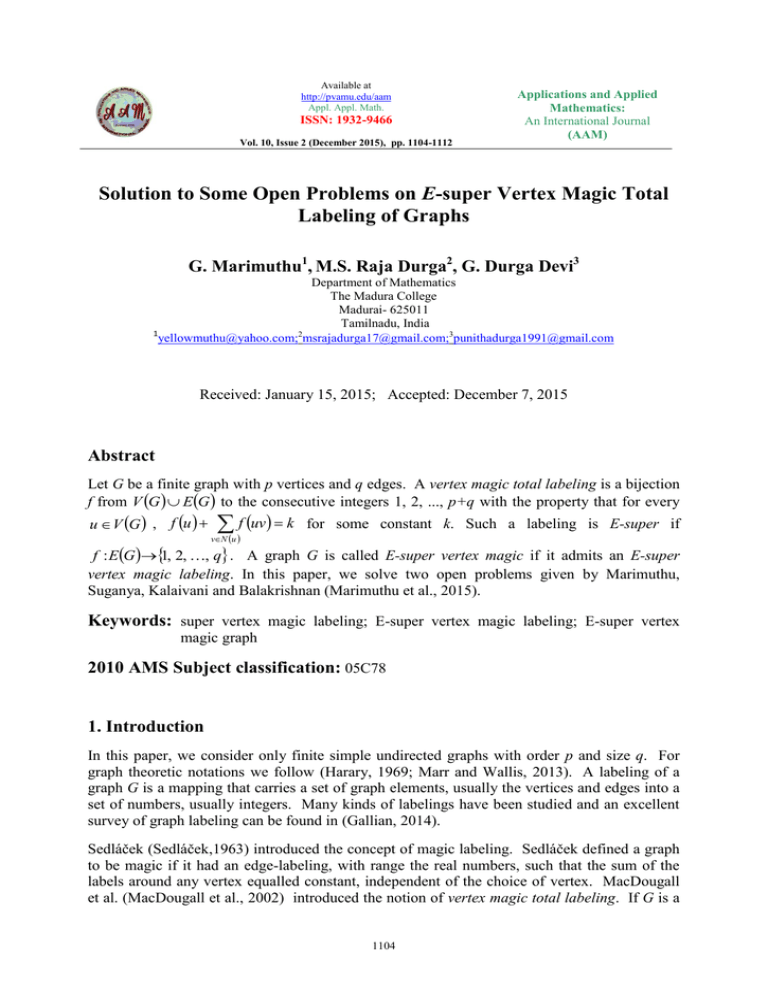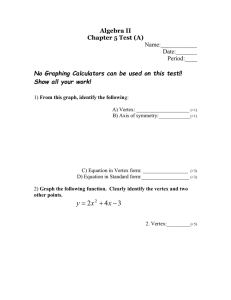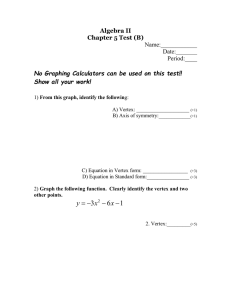E
advertisement

Available at
http://pvamu.edu/aam
Appl. Appl. Math.
ISSN: 1932-9466
Vol. 10, Issue 2 (December 2015), pp. 1104-1112
Applications and Applied
Mathematics:
An International Journal
(AAM)
Solution to Some Open Problems on E-super Vertex Magic Total
Labeling of Graphs
G. Marimuthu1, M.S. Raja Durga2, G. Durga Devi3
Department of Mathematics
The Madura College
Madurai- 625011
Tamilnadu, India
1
yellowmuthu@yahoo.com;2msrajadurga17@gmail.com;3punithadurga1991@gmail.com
Received: January 15, 2015; Accepted: December 7, 2015
Abstract
Let G be a finite graph with p vertices and q edges. A vertex magic total labeling is a bijection
f from V G E G to the consecutive integers 1, 2, ..., p+q with the property that for every
u V G , f u
f uv k
vN u
for some constant k. Such a labeling is E-super if
f : EG 1, 2, , q . A graph G is called E-super vertex magic if it admits an E-super
vertex magic labeling. In this paper, we solve two open problems given by Marimuthu,
Suganya, Kalaivani and Balakrishnan (Marimuthu et al., 2015).
Keywords: super vertex magic labeling; E-super vertex magic labeling; E-super vertex
magic graph
2010 AMS Subject classification: 05C78
1. Introduction
In this paper, we consider only finite simple undirected graphs with order p and size q. For
graph theoretic notations we follow (Harary, 1969; Marr and Wallis, 2013). A labeling of a
graph G is a mapping that carries a set of graph elements, usually the vertices and edges into a
set of numbers, usually integers. Many kinds of labelings have been studied and an excellent
survey of graph labeling can be found in (Gallian, 2014).
Sedláček (Sedláček,1963) introduced the concept of magic labeling. Sedláček defined a graph
to be magic if it had an edge-labeling, with range the real numbers, such that the sum of the
labels around any vertex equalled constant, independent of the choice of vertex. MacDougall
et al. (MacDougall et al., 2002) introduced the notion of vertex magic total labeling. If G is a
1104
AAM: Intern. J., Vol. 10, Issue 2 (December 2015)
1105
finite simple undirected graph with p vertices and q edges, then a vertex magic total labeling of
G is a bijection f from V G E G to the integers 1, 2, ..., p+q with the property that for
every u in V(G),
f u
for some constant k, where
f uv k ,
vN u
N u vV G : uv EG .
They studied the basic properties of vertex magic total graphs and showed some families of
graphs having vertex magic total labeling.
MacDougall et al. (MacDougall et al., 2004) further introduced the super vertex magic total
labeling. They called a vertex magic total labeling f is super if f :V G 1, 2, , p.
Swaminathan and Jeyanthi (Swaminathan and Jeyanthi, 2003) introduced a concept with the
name super vertex magic total labeling, but with different notion. They called a vertex magic
total labelling f to be super if f : EG 1, 2,, q. To avoid confusion, Marimuthu and
Balakrishnan (Marimuthu and Balakrishnan, 2012) called a total labeling f as an E-super vertex
magic total labeling if f : EG 1, 2,, q. They studied the E-super vertex magicness of
even regular graphs. Most recently Wang and Zhang (Wang and Zhang, 2014) extended the
results found in the article (Marimuthu and Balakrishnan, 2012).
Theorem 1.1. (Swaminathan and Jeyanthi, 2003)
A path Pn is E-super vertex magic if and only if n is odd and n 3 .
Theorem 1.2. (Swaminathan and Jeyanthi, 2003)
If a non-trivial graph G of order p and size q is super vertex magic, then the magic constant k is
given by
k q
p 1 qq 1
.
2
p
Theorem 1.3. (Marimuthu and Balakrishnan, 2012)
Every tree T of even order is not E-super vertex magic.
In this article, we partially solve the following open problems given by Marimuthu, Suganya,
Kalaivani and Balakrishnan (Marimuthu et al., 2015).
Open problem 1.4. Discuss the E-super vertex magicness of Bn, n t , when t 2.
Open problem 1.5. Find all E-super vertex magic wounded suns, Cn me , m 3 .
1106
G. Marimuthu et al.
2. Solution to the Problems
Definition 2.1.
A broom Bn , d is defined by attaching n-d pendant edges with any one of the pendant vertices
of the path Pd .
Theorem 2.2.
The broom Bn, n1 is E-super vertex magic if and only if n is odd and n 3 .
Proof:
As the broom Bn, n1 is isomorphic to a path Pn the results follow immediately from Theorem
1.1.
Theorem 2.3.
The broom Bn, n t is not E-super vertex magic for n t 2, t 3.
Proof:
Let
V Bn, nt v1 , v2 , ..., vnt , u1 , u2 , ..., ut
and let
E Bn, nt vi vi1 ,1 i n t 1 vnt u j ,1 j t.
Then, Bn, n t has p n vertices and q n 1 edges.
As Bn, n t is a tree, according to Theorem 1.3, n can’t be even.
Assume that n is odd.
Suppose Bn, n t is E-super vertex magic. Then, there exists a E-super vertex magic total labeling
of Bn, n t , say, f. According to Theorem 1.2 the magic constant k is given by
p 1 qq 1
2
p
n 1 n 1 n
n 1
2
n
n 1
n 1
n 1
2
n 1
2n 2
2
5n 3
.
2
k q
AAM: Intern. J., Vol. 10, Issue 2 (December 2015)
1107
Now, we determine the smallest possible value of the sum
f vnt
f vnt u f vnt f vnt u j f vnt 1vnt .
t
uN vn t
j 1
The smallest possible value of the set f vnt u j :1 j t is
k p q j 1
k 2n j : 1 j t.
Also, the smallest possible values of f vnt 1vnt and f vnt are 1 and n, respectively.
Therefore, the smallest possible value of the above sum is:
t
n k 2n j 1 n 1 tk 2nt 1 2 ... t
j 1
n 1 tk 2nt
t t 1
2
t2 t
5n 3
n 1 t
2nt
2
2
2
t 2n t 1 1 , t 3
2
5n 3
2
k.
t
Therefore, the value of the sum at vnt is at least n k 2n j 1 exceeds k, a
j 1
contradiction. Hence, the result follows.
Note that
t
n k 2n j 1
j 1
exceeds k by
t 3n t 12 4 .
2
Definition 2.4.
The sun graph C n is defined as follows:
V (Cn ) {v1 , v2 , ... , v2 n }.
E (C n ) {vi vi1 , 1 i n 1} {vn v1} {vi vn i ,1 i n}.
The graph Cn me, m n is obtained by removing {v2n , v2n1 , ..., v2nm1} and the edges adjacent
to them from Cn . This is referred as a wounded sun.
1108
G. Marimuthu et al.
Theorem 2.5.
A wounded sun C n me , 3 m n , is E-super vertex magic if and only if m is odd and
m 1.
Proof:
Let C n me be a wounded sun, where m is a positive integer such that 3 m n . Then,
V (Cn me) {v1 , v2 , ... , vn }{vn1 , vn2 , ... , v2n m }
and
E (Cn me) {vi vi1 , 1 i n 1} vn v1{vi vni , 1 i n m}.
Thus, Cn me has p 2n m vertices and q 2n m edges.
Assume that C n me , m 3 is E-super vertex magic. Then, by Theorem 1.3, the magic
constant k is given by
p 1 qq 1
k q
2
p
p 1
p
p 1
2
p 1
2 p 1
2
2n m 1
22n m 1
2
m 1
4n 2m 1 n
2
5m 1
5n 1
,
2
which is an integer only when m is odd.
Suppose m = 1. Then.
V (Cn e) {v1 , v2 , ..., vn }{vn 1 , vn2 , ..., v2 n1}
and
E (Cn e) {vivi 1 , 1 i n 1} vnv1{viv n i, 1 i n 1}.
Thus, Cn e has p 2n 1 vertices and q 2n 1 edges. Since Cn e is E-super vertex magic,
it has a E-super vertex magic labeling. Therefore, for each vertex v V Cn e , the total
weight wt v , (the sum of the labels of the vertex v and that of the edges incident to v) is a
constant k 5n 1 . Since there are n-1 pendent vertices and n-1 pendent edges, the only
AAM: Intern. J., Vol. 10, Issue 2 (December 2015)
1109
possible set of the labels of the pendent vertices is 3n, 3n 1, , 4n 2 p q and the only
possible set of the labels of the pendent edges is n 1, n 2, , 2n 1 q. Therefore, at
the vertex
vn , the largest possible label of the vertex vn
is 3n-1 and the largest possible labels
of the two edges incident to this vertex are n-1 and n. Thus, the largest possible value wt vn is
3n 1 n 1 n 5n 2 5n 1 k .
That is, the largest possible value of wt vn is less than k. Therefore, wt vn k , a
contradiction. Hence, m is odd and
m 3 .Then, m 5.
m 1 . Conversely, assume that m n is odd, m 1 and
If m n , then the wounded sun Cn me is the cycle Cn. By Theorem 1.2, Cn me is E-super
vertex magic.
Now let 5 m n 1. Define a total labeling
f : V E 1, 2, ..., 4n 2m
as follows:
f v1 2n 1,
f vn 3n m ,
f vni 2n m i, 1 i m 2 ,
f vi1 3n m i, 1 i n m ,
f vni 3n m i, 1 i n m ,
f vi vi 1 i, 1 i n m ,
f v1vn n m 1,
m 1
f vi vni 2n i 3
, 1 i n m ,
2
m 1
f vn2i vn2i 1 2n m 1 i,1 i
,
2
m 1
m3
f vn2i 1vn2i 2 n
.
i, 1 i
2
2
From the above labeling, we have,
V Cn me v1 vn vni , 1 i m 2 vi1 , 1 i n m vni , 1 i n m.
Now,
f v1
f v u f v f v v f v v f v v
uN v1
1
1
1 2
1 n
1 n1
m 1
2n 1 1 n m 1 2n 1 3
2
5m 3
3 5m
5n
.
= 5n
2 2
2
1110
G. Marimuthu et al.
f vn
f v u f v f v v f v v
uN vn
n
n
n n1
n 1
m 3
3n m n m 1 n
1
2
3 5m
5n
.
2
f vni
f v u f v f v
uN vn i
n i
n i
v
n i n i 1
f vni vni1
i 1 m 3 i 1
n
2 2 2
2n m i 2n m 1
5n
f vi1
3 5m
, 1 i m 2.
2
f v u f v f v
uN vi 1
i 1
i 1
v f vi1vi2 f vi1vni1
i 1 i
m 3
3n m i i i 1 2n m i 1
2
5n
f vni
3 5m
, 1 i n m.
2
f v u f v f v v
uN vn i
n i
n i
i n i
m 1
3n m i 2n i 3
2
3 5m
5n
, 1 i n m.
2
Therefore,
for every v V Cn me , f v
f uv 5n
uN v
3 5m
.
2
Hence, f is an E-super vertex magic labeling of V Cn me with magic constant
k 5n
where m is odd,
m 1 and m 3 .
3 5m
,
2
An illustration for Theorem 2.5 is given in Figure 1.
AAM: Intern. J., Vol. 10, Issue 2 (December 2015)
1111
Figure 1. An E-super vertex magic labeling of C15 9e
3. Conclusion and Scope
In this article, we have solved two open problems given by Marimuthu, Suganya, Kalaivani
and Balakrishnan (Marimuthu et al., 2015). There is another open problem for further
investigation in the same paper which is given as follows:
Open problem 1. Characterize all E-super vertex magic trees of odd order.
Acknowledgment
The authors would like to express their gratitude to the anonymous referees for their kind
suggestions and useful comments on the original manuscript, which resulted in this final
version.
REFERENCES
Gallian, J. A. (2014). A dynamic survey of graph labeling, Electron. J. Combin. 16: #DS6.
Harary, F. (1969). Graph Theory, Addison- Wesley.
MacDougall, J. A, Miller, M, Slamin, Wallis, W. D. (2002). Vertex magic total labelings of
graphs, Util. Math., 61: 3-21.
MacDougall, J. A, Miller, M, Sugeng, K. A. (2004). Super vertex magic total labelings of
graphs, Proc. of the 16th Australian Workshop on Combinatorial Algorithms, pp. 222229.
Marimuthu, G and Balakrishnan, M. (2012). E-super vertex magic labelings of graphs,
Discrete Appl. Math., 160: 1766-1774.
1112
G. Marimuthu et al.
Marimuthu, G, Suganya, B, Kalaivani, S, Balakrishnan, M. (2015). E-super vertex magic
labelling of graphs and some open problems, Appl. Appl. Math., 10 (1): 536-543.
Marr, A. M and Wallis, W. D. (2013). Magic Graphs, Birkhauser - Springer, Second edition,
Boston.
Sedláček, J., Problem 27. (1963). Theory of Graphs and its Applications, Proc. Symposium,
pp. 163-167.
Swaminathan, V and Jeyanthi, P. (2003). Super vertex magic labelling, Indian J. Pure Appl.
Math., 34 (6): 935-939.
Wang and Zhang, (2014). Note on E-super vertex magic graphs, Discrete Appl. Math., 178:
160-162.






